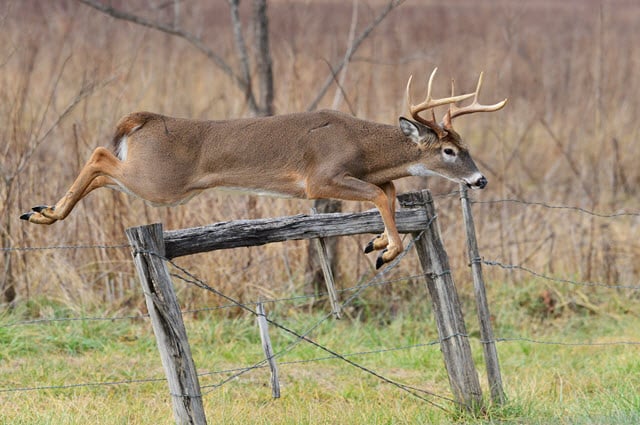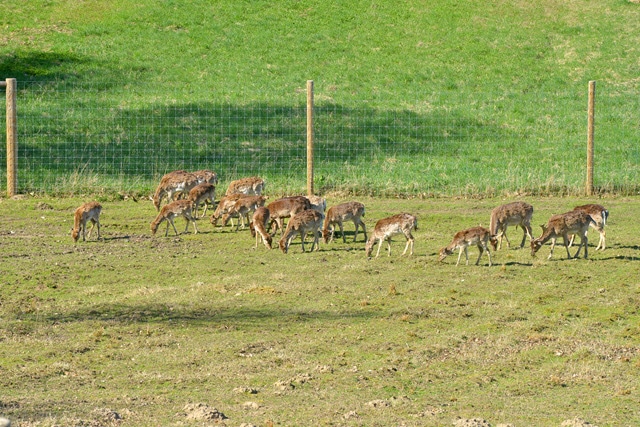Deer are one of the most agile animals in the forest, and they’re able to run fast, jump high, and they even swim well. The ability to quickly flee and escape potential danger makes deer adaptable, and it’s why they are at home in places inhabited by people. Knowing how high a deer can jump can help you avoid these problems and keep your garden safe from deer. So, how high can deer jump?
How high a deer can jump depends on the type of species the deer is. Most deer can jump about eight feet high, but some deer can jump higher. And when running, their leaps can carry them distances of up to thirty feet!
The good news is that you don’t need to live in a high-walled castle with a thirty one foot moat around it to keep deer out of your yard.
The following article is a more in depth explanation of how high deer can jump, specifically white tailed deer. It also includes a short guide on how to build an effective deer fence.
Can Deer Jump a Fence?
Deer can and will jump a fence if they see something that catches their eye. Deer are curious animals by nature, so if they see or smell something that piques their interest, they will try to get to it.

However, deer are also known for being efficient with their energy use. They try to conserve as much energy as possible in case they need to make a quick escape from predators.
As a result, a tall fence might be a good enough reason for them to skip your yard and move on to your neighbor’s garden.
Why Do Deer Jump Fences? (common reasons)
Some of the most common reasons that a deer will jump a fence include:
- Safety
- To mate
- Hunger
Deer are constantly aware of their surroundings and will do anything necessary to get away from danger. If they sense that something might be a threat, then they will immediately start to flee, taking the shortest route available to them. When there’s a fence in the way, they have no problem jumping over it.

When deer spot a potential mate, they are willing to do whatever it takes to get to them. This is especially true in male deer and, understandably, during mating season.
Deer experience the hormone oxytocin more intensely than humans do when they spot the opposite sex. This leads to them getting to their mate by any means necessary, including jumping fences.
The final reason that deer jump fences is the most common one, hunger. Food is available to deer the majority of the time in the woods, but they are curious creatures. If they smell or see something that they think would make a delicious snack, they will go after it immediately.
A short fence in the way is no match for a hungry and curious deer.
How High Does a Deer Fence Need to Be?
Whether you are trying to keep deer out or in (because you’re raising a herd of deer on a farm), an effective deer fence should be at least seven and a half feet high.
Even though deer can jump an average of eight feet, they won’t risk jumping a fence they are uncertain about. Seven and a half feet is just high enough to make a deer uncertain. The animal’s depth perception is such that it won’t be able to tell if the fence is safe to jump.

An eight foot fence can also do the trick if you have higher jumping deer in your area. You can also use a lower fence at six or seven feet high, but it’s recommended that you angle it slightly.
A forty-five degree angle should be just enough of a slant to keep deer out. The angling will give the deer the illusion of the fence being higher, so they will be less likely to jump it.
Another option you have is installing two low fences four feet apart, and each fence being about five feet in height.
Deep don’t have the ability to estimate distance correctly, so the fences will look closer and higher than they actually are. They won’t risk getting caught between the two fences, so they are less likely to jump.
How High Can Whitetail Deer Jump?
The average height a whitetail deer can jump from a standing position is between six and eight feet.Though they are able to jump up to twelve feet high with a running start. They only do this when escaping a dangerous situation, however.

A seven and a half foot tall fence is able to keep whitetail deer from jumping it. But if you want to be safe, an eight foot fence is highly recommended.
How High Can Mule Deer Jump?
Mule Deer are able to jump up to three feet high from a standing position. While that may seem miniscule, they are able to jump an average of fifteen feet high with a running start.

An eight foot tall fence is recommended if you have mule deer in your area. They don’t jump as high as fifteen feet often, but an eight foot fence is still a good idea and will discourage them from jumping.
Best Types Of Deer Fencing
The best types of deer fencing include:
- Electric fences
- Woven wire fences
- Poly tape fences
Electric Fence for Deer
Electric deer fences are the easiest and quickest fences to build. They are also the least expensive type of fencing, so they are perfect for fencing larger areas of land.
This type of fence only needs to be about five feet high. But an electric deer fence is designed to deter a deer from wiggling through it rather than jumping over it. So if you want to make it seven and a half feet high, then it’s possible to do so.
An electric deer fence is also the best way to keep deer away from the fence altogether. Once a deer comes into contact with a hot fence, it will know that the fence is potentially dangerous. This will keep the deer from coming near the fence again, making your land more secure.
Woven Wire Deer Fencing
A woven wire deer fence is the best option for long term land protection. It lasts the longest out of any fence option and is the easiest to maintain. It’s made with wooden or steel posts on the corners and woven steel wire connecting them.

The fence needs to be about six feet tall from the bottom of the ground, but it can be higher if there are high jumping deer in your area.
Electric Poly Tape Fence
Lastly, poly tape deer fences are the best type of fence for small gardens and small plots of land.
They are the least expensive type of deer fence to build, but will still be effective at keeping deer from jumping it. This deer fence is made by putting wooden or steel posts at each corner of the garden or land plot, and installing poly tape between each post.
Poly tape is made from woven strands of polyethylene, which make it a strong fence building material. The fence needs to be about six feet high from the ground up, but it can also be built higher.
Final Thoughts
Building a deer fence is the most effective and safe way to keep deer out (or in).

There are a variety of reasons why a deer will jump over a fence, but most of the time they won’t risk it if they aren’t sure about what’s on the other side.
The best types of deer fences are those that are an acceptable height and made from the most effective materials.
It’s recommended that you check to see what type of deer are in your area so you can build the best fence around your land to control the movement of deer into and out of your property.


